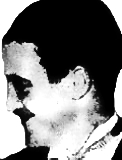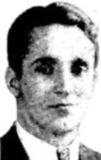Andrew Carnegie Whitfield
Andrew, circa 1938
- Missing Since 04/17/1938
- Missing From Long Island, New York
- Classification Missing
- Sex Male
- Race White
- Age 28 years old
- Height and Weight 5'8, 155 pounds
- Clothing/Jewelry Description A dark gray Brooks Brothers suit, a White shirt with an attached collar, low black shoes, a gray fedora, a silver wristwatch and a gold signet ring with an engraved dove on his left hand.
- Associated Vehicle(s) Small silver and red Taylor Cub monoplane
- Distinguishing Characteristics White male. Graying brown hair, blue eyes. Andrew may go by his initials, A.C. He has an appendectomy scar on his abdomen, and one false upper front tooth.
Details of Disappearance
Andrew departed in his small silver and red Taylor Cub monoplane from Roosevelt Field on Long Island, New York sometime after 9:00 a.m. on April 17, 1938. He planned to land at an airfield in Brentwood, approximately 22 miles away. He was only supposed to be in the air for fifteen minutes, but Andrew never arrived as scheduled. His plane has never been recovered.
He had 200 hours of flying experience at the time of his disappearance, just 50 hours short of the time necessary to obtain a commercial pilot's license, and was described as an accomplished pilot. His plane had enough fuel for a 150-mile flight.
Andrew checked into a hotel in Garden City on Long Island under the alias Albert C. White on the day he vanished. He paid $4 in advance for the room and never checked out. His personal belongings, including his passport; clothing; cuff links engraved with his initials; two $6,000 life insurance policies in his name listing his wife, Elizabeth Halsey Whitfield, as the beneficiary; and several stocks and bonds made out in Andrew's and Elizabeth's names; were left behind in the hotel room.
Phone records also indicated that he called his home while his family was out looking for him, and a telephone operator says she heard him say over the phone, "Well, I am going to carry out my plan."
After this information was uncovered, police theorized that Andrew had committed suicide by deliberately flying his plane into the Atlantic Ocean. There is no evidence to support this theory; a thorough search of the ocean surrounding Long Island turned up no signs of plane wreckage and Andrew was not having personal or business problems at the time that he vanished. He had married in 1937, and had planned to move to Bethlehem, Pennsylvania the same month that he disappeared.
Elizabeth sued Andrew for desertion after his disappearance. She explained that she did not believe he had deliberately abandoned her, but she thought the suit would be a way to better publicize his disappearance. Many people across the United States claimed that they saw Andrew for years after his plane vanished.
Andrew was the nephew of the steel tycoon Andrew Carnegie on Carnegie's wife's side. He was a graduate of Princeton University and was employed as a business executive in 1938.
He was declared legally dead in 1946 and his case has long been closed by law enforcement due to the passage of time, but Andrew's disappearance continues to mystify people.
Investigating Agency
- None
Updated 4 times since October 12, 2004. Last updated February 22, 2010; three pictures added, distinguishing characteristics updated.




